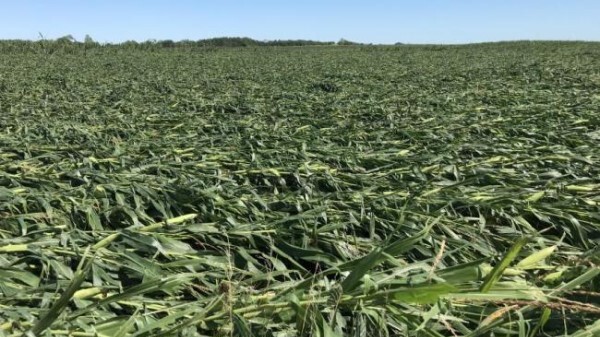A violent storm damaged millions of acres of corn and soybean fields in the Midwest earlier this month, leaving some farmers without hope of a worthwhile fall harvest.
The crops were flattened and torn apart by a derecho on Aug. 10. A derecho is a particularly damaging and severe windstorm that can produce hurricane-force winds, tornadoes and heavy rains. Derechos often travel hundreds of miles, causing widespread destruction.
This derecho barreled through several states across the nation’s heartland, but most of the crop damage happened in Iowa, where wind gusts exceeded 100 mph. As many as 14 million acres of farmland were damaged by the storm, according to estimates from various state officials. The hardest-hit counties, 36 of them, included early estimates of 3.6 million acres of corn and 2.5 million acres of soybeans lost.
“It’s by far the most extensive and widespread damage that we’ve seen on this farm,” Aaron Lehman told Harvest Public Media. Lehman grows corn and soybeans in Polk County in central Iowa and is president of the Iowa Farmers Union. He said the damage was worse than a typical tornado.
“Unlike a tornado, which is a mile wide, this stretched for a width of really intense damage — of approximately 40 miles, probably closer to 60-70 miles wide,” he said.
Besides crushing crops, the derecho mangled grain bins, ruining hundreds of millions of bushels of commercial storage grains and on-farm storage grains.
The true financial losses probably won’t be known for weeks, but even farmers whose fields were not leveled will suffer losses.
“It’s hard to really get your arms around the devastation at this point,” Shannon Textor, a spokeswoman for the Iowa Corn Growers Association, told The New York Times.

Brian Sampson of Nevada, Iowa, said about 80% of his 1,000 acres of corn were destroyed. A building that houses cattle, called a hoop building, was ripped apart, and the roofs of a grain bin and another small outbuilding were destroyed as well. The property damage alone could cost him $350,000, not including the reduction of his corn harvest.
The storm also destroyed the roof of Sampson’s home, and the water that blew inside started to smell.
“It’s depressing to see all your work, and all your neighbors’ hard work and everything you were trying to do — and it just gets wiped out in 10 minutes,” Sampson said.
While some Iowa farmers have been left reeling, others escaped major damage. This, plus surviving crops from neighboring states could salvage the overall Midwest growing season.
Jared Flinn, operating partner at BulkLoads, a third-party service that provides load-matching, payment and technology solutions for the bulk trucking industry, told FreightWaves that he doesn’t expect to see much loss of yields and production in overall crops across the Corn Belt. He said beans are pretty hearty and can take a beating. However, the situation with corn is different.
“Corn could be a little trickier as the stalks will break and die,” Flinn explained. “Some farmers may still be able to go in and get 60-70% of the volume, but overall the yield is already made with these crops so it’s just a matter if they can get it out of the field.”
In relation to freight, Flinn said that trucks on average haul 900 to 1,000 bushels per load. Corn typically produces 200 bushels per acre and soybeans around 80 bushels per acre. So, based on the preliminary loss numbers, the derecho damaged or destroyed approximately 720 million bushels of corn and 200 million bushels of soybeans, totaling 920 million bushels. This is equal to a loss of around 1 million potential truck loads from the region come harvest time.
“So depending on how much is damaged, it can take a chunk of truck loads away that would normally move,” Flinn added. “Seems like traders are more optimistic about the damage.”
Flinn added that the Corn Belt overall is set to see record crops. So, he feels the derecho won’t have a huge impact on the overall freight markets.
On Sunday, Iowa Gov. Kim Reynolds requested an expedited federal disaster declaration to aid counties ravaged by the derecho. The next day, President Donald Trump approved part of Iowa’s disaster aid request, encompassing about $45 million in aid. However, Reynolds’ total disaster aid application included nearly $4 billion in damages. The Monday approval did not include individual assistance aid, which would help homeowners and farmers with their private property damage.










